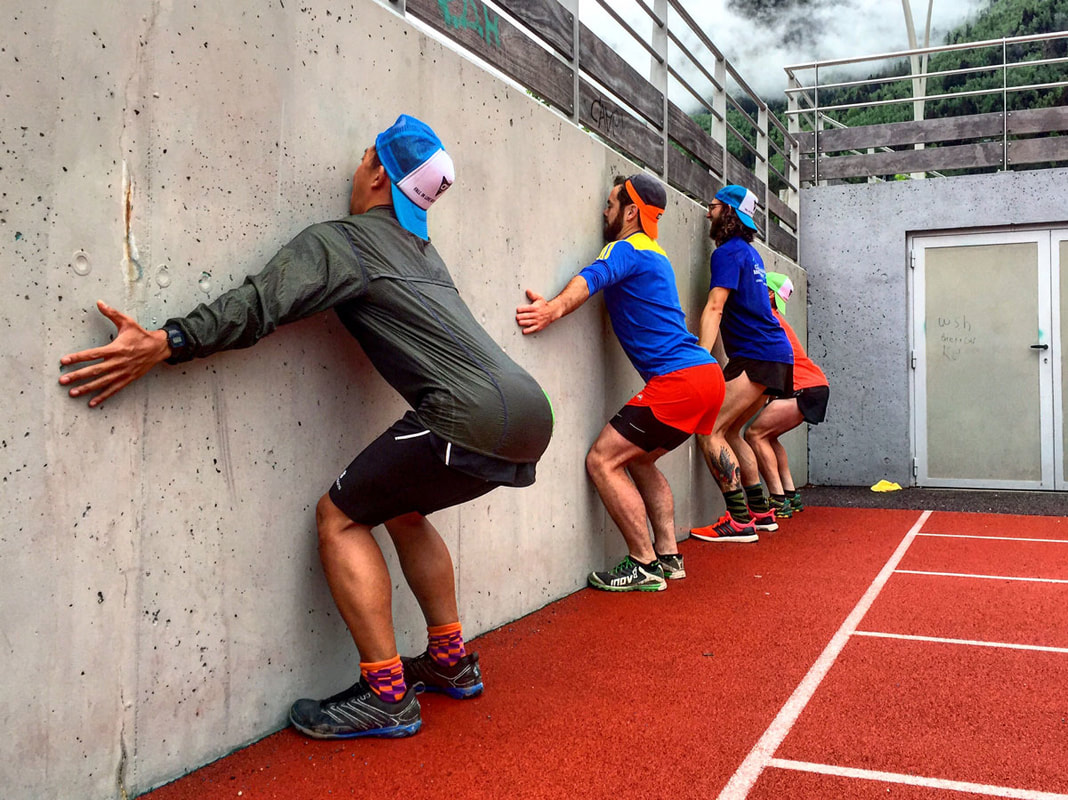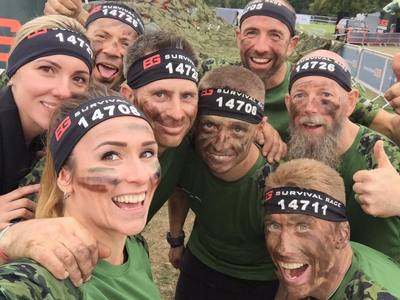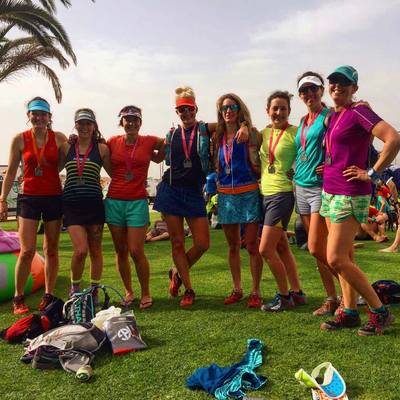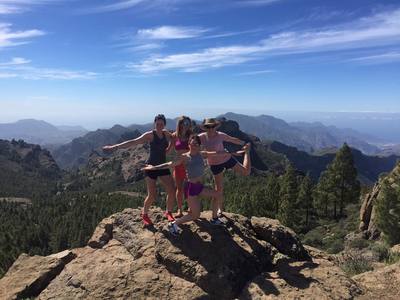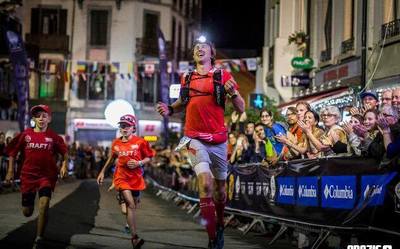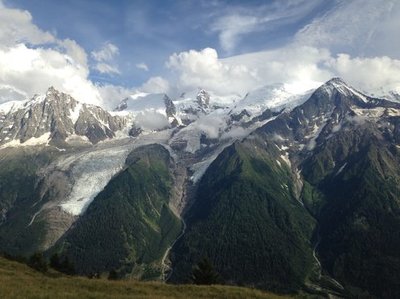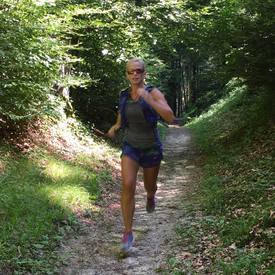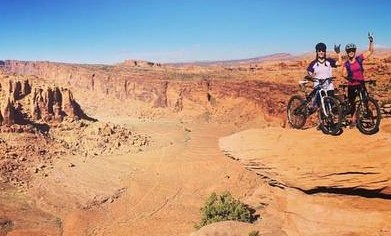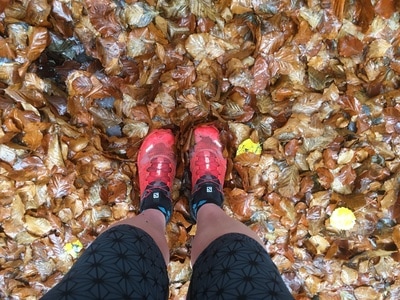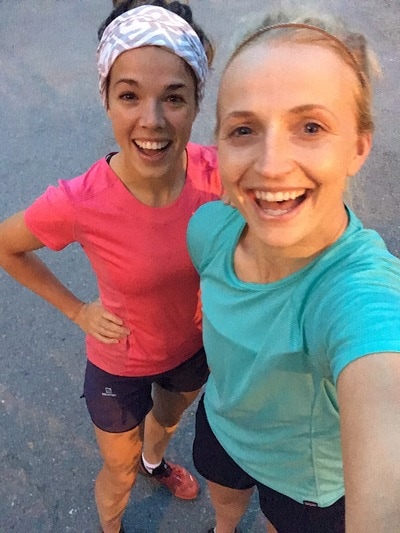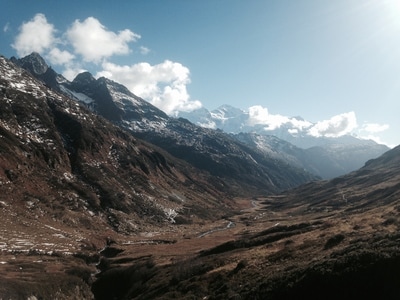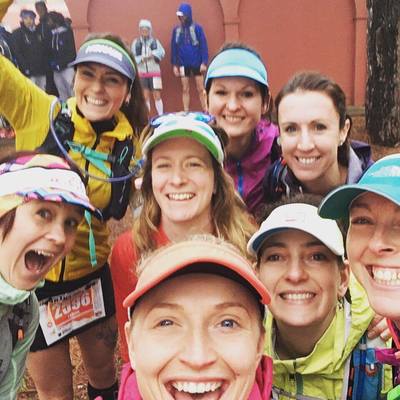|
Following on from Charley's previous post, now is a key time to get some solid workouts in. We're ahead of the summer season, but still with enough time to make a real impact on your strength. And for those of you that hate the gym, this can be done anywhere. So no excuses! Running is hard on your body, there is no doubt, and your body needs to develop the strength and resistance for the miles you put it through. However, running too many miles without the relative strength, stability and mobility opens you up for injury and, potentially, missing your race. Here is the workout Charley did with the AR Collective crew out here in Chamonix. A simple yet effective all-round workout for runners. Warm up - mobility First, I like to move all body parts; perform each for 15-30 seconds:
Warm up - heart rate & movement Now to start raising the heart rate and priming the movements we will be training. Between each movement, perform 10 Pop & Stops.
Workout - part 2 Core integrity is crucial to running form and so we finished off with a short but challenging core drill. The movement is front leaning rest (FLR), or, to most, press up position. With short sets, the aim is to generate as much tension in the body as possible, pulling the heels of your hands towards your toes, forcing you to fully engage your core and rest of your body. For 5 rounds, perform:
Workout - part 1 The main part of the workout is a strength and stability superset combining the Bulgarian split squat with single leg deadlift. For 5 rounds, perform:
Stretching - Moving through the whole body, I like to spend a good 5 – 10 minutes stretching at the end of a session.
Good luck! Charley Radcliffe is a Personal Trainer and Community Manager for The North Face, based in Chamonix, France.
1 Comment
People often ask me why I run. Running for me is friendship, freedom and adventure! It has brought me so many opportunities and given me so much, but before I go into all of that I’ll tell you where I started. 13 years ago, I signed myself up to a local half marathon. All went fine, I completed it and then stopped running. The race had passed and my motivation was gone too. A few years later I saw my friend Laura getting involved in obstacle races and I thought “I wonder if I could do those?” They looked so challenging and I hadn’t run in a few years. It seemed so unachievable. One day I went along to support her, planning to take my camera and see what this obstacle racing malarkey was all about. I did just that, running through fields, trying to track her and see where she was going next. I must have run miles and miles that day, but I didn’t notice it at all, I was having so much fun. I decided to commit and sign myself up for an obstacle race, picking Laura’s brains on every detail, how to train? What shoes to wear? What clothes to wear? She helped me train and gave advice; she was my Mr Miyagi of obstacle racing! I discovered running in the mountains on a recent trip to the Altas mountains in Morocco. This came about from a series of tweets and me being impulsive. I’d been running the trails where I lived and my distance had increased significantly from the parkruns I started out with, but I’d never been running in the mountains before at high altitude and doing multiple days of longer distances. Maybe I had bitten off more than I could chew? But it turned out to be the trip that made me fall in love with the mountains. I’d never seen anything like it in my life and I never thought for a second I’d be running through such amazing places. The trip opened my eyes to the fact that there are so many beautiful places to explore and what better way to do so than to run around them. The friendships I made on that trip that will stay with me for life. I kept in touch with the people I met on that trip, went on a running trip to Chamonix and caught up with many of them. So when I was asked to join them on a trip to Gran Canaria, it was an easy “yes”. And so I found myself running my first trail marathon. There is something about running, especially trail running, that seems to bring people together. I can’t explain what it is - maybe it’s an appreciation and love of the same thing? Getting out on the trails, seeing those epic views, having low moments where a complete stranger helps pick you up and keep you on track, you go through the highs and the lows together. Those moments where you find yourself in the most breathtakingly beautiful of places, feeling completely and utterly free. Free from the stresses of life, with a feeling of belonging. Running has built my confidence and changed my life on so many levels.
So what are you waiting for? Grab those trainers, get out on those trails and make some memories! Karina is a Hoka One One Flyer https://www.instagram.com/grimes77/ External validation, has it become proof of the fact? How is it possible to achieve something, yet not feel a sense of accomplishment until it’s recorded on a remote database or posted to an activity feed for all the world to see? Recently I was 34km into a Sunday Long Run when my watch battery died. I stopped in my tracks. Then I headed home. There was no point continuing, no reason at all. If I continued running for the final 6km, to make up the planned 40km, it wouldn't be real. Does this make sense? No, it doesn’t! It defies all logic. Yet, this was the nonsense going through my head, the predicament I faced. I actually thought it would be better for my training if I stopped, recharged my GPS and went out in the evening for the remaining 6km. The reality is that it would not have been better; splitting my long run would have totally negated the training stimulus I was trying to achieve. This was a training stimulus I had built towards over the past six weeks, steadily increasing my long run, week on week, safely approaching a longer distance. Yet here I was, stopped dead on the trail, not wanting to run any further if I couldn’t record my distance, time or elevation. How would anyone know it happened? How would I be able to look back with pride and affirm I did the hard yards? The answer is - it wouldn’t be possible. And I’ve come to realise that this is totally fine. In the ‘Real World’, where blood, sweat and tears are shed upon the trails, if it happened, it happened regardless of whether it’s recorded on your watch or phone. What matters is you physically went out and trained. The real evidence of training - and the only evidence that matters - is your performance on race day and your ability to live with a healthy body and mind.
External validation has gained far too much importance in today’s society. It’s a downside to the power of technology. More and more people are feeling a sense of illusion if they don’t document and externally validate something they have done. Yet this defies logic and it’s simply ridiculous. GPS watches, smartphones and social media can help you train better by monitoring heart rates etc. However, in themselves, they have not contributed to faster times and/ or better fitness. Only the real work, the hard yards and “getting it done” results in greater performances and improvements. So, what did I do at 34km of my long run? I got to the front door and thought: “This is rubbish. If I did the work but it’s not on Strava, it still bloody happened.” Then I turned around and finished the run. Keep Healthy, Injury Free and Train Like You Want It. Tally Ho!! Majell Backhausen is an athlete and coach. www.majellbackhausen.com Running is hard on your body, there is no doubt, and your body needs to develop the strength and resistance for the miles you put it through. However, running too many miles without the relative strength, stability and mobility opens you up for injury and, potentially, missing your race. Over the past few years, I have had the privilege of meeting a number of top flight runners, climbers, and cyclists passing through or living in my home town of Chamonix. As I prepare for my trail running season and work with others on their preparations too, I have put together a basic strength workout that will not just make you run faster, but also prevent injury and allow you to enjoy longer days in the mountains - well that is the plan, at least! My top 3 strength, stability & mobility exercises for trail running There is so much that could go here but I wanted to highlight 3 exercises that I feel have had the biggest benefit to my body when it comes to long days in the hills, be them spent running, hiking, or climbing. 1) Prying squats - a mobility exercise The prying squat is one of the first movements I teach personal training clients and it is a great and simple test to see range of motion and core strength. People often struggle with the concept of how low you are meant to go with this movement but, with a little encouragement, everyone can get down to the bottom. The prying squat is a deep squat with you butt as close to the floor as possible then prying your knees apart, opening up your hips.
2) Single leg deadlifts - a stability exercise Single leg deadlifts are a superb way to assess the imbalances that most of us have between our left and right legs. By working on our single leg balance and then building on the strength, we build up the stability in the foot, ankle, knee and hip.
3) Bulgarian split squats - a strength exercise
Whether you have weights or not, the Bulgarian split squat is an awesome movement to make your quads work hard. By only using one leg but using the other for balance, you test and build the strength of the major muscles - your quads - and build on the stability on your feet, ankles, and knees.
Charley Radcliffe is a Personal Trainer and Community Manager for The North Face, based in Chamonix, France. One of the most frequent questions I am asked as a runner moonlighting as a researcher in high altitude exercise physiology, is how to train for a race at altitude while living close to sea level. Imagine you live in London and found yourself winning a place at the CCC. After your initial excitement, you panic realizing you only have one week of annual leave remaining and cannot spend much time getting yourself acclimatized to the higher altitude trails of Chamonix. Are you doomed to fail? Certainly not! There are some intricate changes that happen in the body to adapt to the changing partial pressure of oxygen at altitudes greater than 1800m. Within 24 hours of arrival at altitude, you can expect a faster heart rate and breathing rate, increased urination, a decrease in VO2 max, and increased EPO production (yep, EPO- which gained a lot of attention thanks to a certain cyclist!). These complex interactions may help in explaining the symptoms that may arise from exposure to altitudes above 2000m- such as orthostatic hypotension, hypertension, headache, and acute mountain sickness (AMS). 75% of people will experience some form of AMS within 24-72 hours of ascent to altitude over 1800m. So how can you get ready for this adventure? 4-8 Weeks before race
Chantelle has a Bachelor of Science degree and is currently pursuing a Master of Science in High Altitude Exercise Physiology.
Lover of mountains and all things outdoors. Sometimes I can be a real pain. Just as sometimes, I can be scatty, forget where I have put something, forget to buy more bin bags etc. Often, I can worry too much, over-think and over-analyze. Sometimes, I can be moody and answer in mono-syllables. It's a bad day if you meet me when all of this is happening. We all have our quirks for sure. So what does this have to do with running? Obviously, these traits are not me at my optimum, but I find when I need a bit of ‘me time’, it is running that brings me back. Running on trails is, for me, a bit like a time machine. The day stops, and it is all about the moment on the path. My worries mean nothing to a trail outstretched. Life’s concerns or angsts are inconsequential. I got into trail running without any intention to, in my early twenties, and the love for it hit me like a ton of bricks. Specifically trail running on mountains, I just had a thing for those trails at altitude. My first ultra was in 2014, which spanned from Switzerland back to Chamonix, and it went pretty well. After this, I have continued to run in many different cool and diverse places, from the rugged Lake District to the peaceful and very beautiful Imlil Valley in Morocco. Running is the most intuitive of movements and yet it brought me such a feeling of just being “me”. What is great about it, is that it becomes a really subjective sport. Whether you want to work out something on your mind, whether you want to glide down big valleys or whether you want to go slow and just trundle along to your ipod – there is not official book about how to do it. You just do it your way. It is all about you, that moment, the mountains and that trail. Maybe in some ways it is why the sport can help celebrate my less than perfect bits too. Trails are “scatty” with rocks and roots, but that makes it interesting underfoot. “Overanalysing" can be quite useful when considering that race profile. Being a bit moody on occasion? Well, I often fun a bit faster when I’ve got a bee in my bonnet. I run because it feels great. Trails are fundamentally, roads of adventure. I don’t really think there is such a concept as being ‘good’ or ‘’bad’ at the sport because it accommodates every place, every person and everything. We all have our good and bad moments on the trail, just like in life, yet even these are determined by your experience and relationship with trail running. A sport objectively brilliant but subjectively interpreted.
If you want to try it, or perhaps to take your running in a new direction, it just requires a thrill for the adventure, and a good pair of trail shoes. The rest, is just about you. Milly x It's a common question among runners. Why do you run? Some people think it’s some weird fitness obsession and it ends there. Many have memories of cold, muddy school cross country lessons or have slogged around a local city road race. I always ran as a kid but discovered trail running after moving to the Alps for a winter ski season. It was the perfect antidote to my unhealthy seasonnaire’s lifestyle and I soon found myself running further and enjoying it. I met Nikki supporting friends during a race several years ago. We were both running the Mont-Blanc marathon and said we should hook up for a run sometime. I remember being nervous as I was so used to running alone, but before you knew it we were training together as often as our busy schedules permitted, spending weekends in the mountains and planning future races. We seemed to want the same things from running, to explore new routes and to push ourselves in terms of distance. Ultra-distances and mountain trails appealed to us both, probably as a result of living in Chamonix, the home of the Ultra-Trail du Mont Blanc and where running a marathon is not considered an extraordinary thing to do. It hasn’t always been plain sailing though and our relationship with running and with each other has been tested. Like when I got severe, drug-resistant double pneumonia that landed me in intensive care and hospital for 3 weeks and took a ridiculously long time to recover from. Nikki was always there for me, bringing me running films to watch in hospital, new races to consider and a card signed by Kilian Jornet! However it totally destroyed the uphill power I used to enjoy and it also meant that, as we tried to resume training together, I just couldn’t keep up. Not only had I gotten slower, but Nikki had worked hard to get faster and the gap kept on widening. It was tough to come to terms with these changes, but now we appreciate and understand that we have different abilities and needs from the sport, which sometimes are in line with each other and sometimes are not. Nikki also suffered a major injury which took her out of the running game for the best part of a year. This was another difficult period as Nikki had to sit on the sidelines and miss out on races and adventures that had been planned for a long time. I really missed my running buddy, fully understanding what it felt like to have to take a forced break and miss out on all the fun. When we planned our first overseas trip together with a group of friends, we didn’t start small. We went in, all guns blazing, to the Everest Marathon, which involved flying to Nepal, a two week trek to Everest Base Camp and running a marathon back to Namche Bazaar. Weather conditions were challenging and made the whole experience tough at times, but we took a lot away from that trip and it was the beginning of our plan for this venture. Since then we’ve been to the USA for the 6-day Transrockies Run and have arranged other trips for the Tour du Mont Blanc, the GR5, the Trans Gran Canaria and the Haute Route. Running is something we both used to pursue separately, but doing it together really has changed our lives. Not only does it give us the confidence to be adventurous, but running as part of a group is safer and enables us to explore more. We travel all over the world with our running pals, making more friends and adding to our merry band in the process. We share ideas about kit, routes, races, off-load work stress and have a flipping good giggle. I really couldn’t imagine life without running, or without Nikki of course! I really hope you can join us to share our passion. Sam x
|
Authors
thoughts, feelings and tribulations about running by runners. |
RUN EXPLORE ADVENTURE
The Adventure Running Company Ltd. Registered in England & Wales, no. 10670502
© 2023 The Adventure Running Company All Rights Reserved. Site design by Nikki Barnard // Illustrations by Kate Sutton

